All about the lungwort
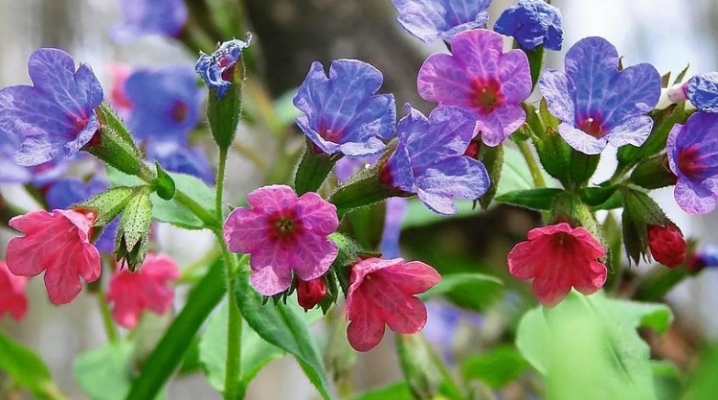
Lungwort is a beautiful herbaceous plant. A flower with such a "sweet" name is considered an excellent honey plant. Therefore, it can be planted in many household plots.
Description
The lungwort is a common perennial. It is also known as vulgaris pulmonaria. The plant is popularly called medunka. The root system of the flower is branched. It is thanks to her that the lungwort grows very quickly over the territory of the site. The stem of the plant is erect. Its surface is covered with short hair. The average height of such a flower is 65-70 centimeters. The foliage of a garden flower can be either round or elongated. She looks very beautiful. There are flowers with silvery, spotted or striped foliage. Like the stems, the leaves can be slightly pubescent. They bloom completely only after the beginning of flowering.
The buds of different flowers also differ. They can be either light pink or deep purple. During the season, their shade may well change. The lungwort usually blooms from early April to late May. At this time, the plants attract bees with their delicate scent. After the end of flowering, a small bean appears in the place of the inflorescence. Inside it is a seed. It is with these seeds that plants reproduce in natural conditions.
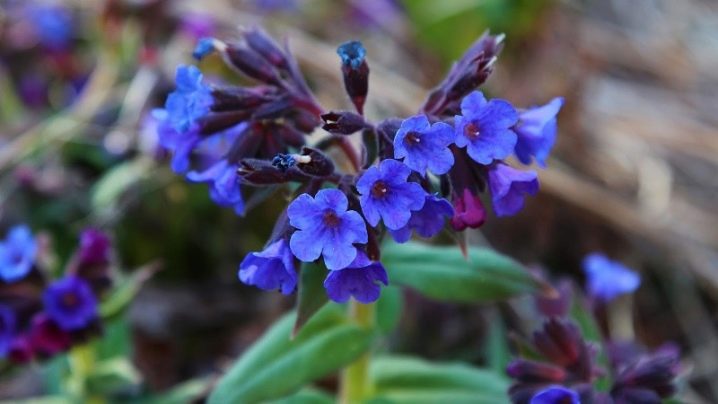
Types and varieties
Now there are many varieties of lungwort. The most popular are the following types of plants.
- Flap... Such a lungwort is considered quite unusual. In nature, it is very rare. The main feature of this flower is its foliage. Over time, it turns from dark green to silver. Lumpy lungwort blooms in early spring. Her buds are large and purple-red.
- Long-leaved... This is a short flower. In height, such a lungwort grows up to 20-30 centimeters. The leaves of the plant are large, covered with silvery spots. The flowers of the spotted lungwort look quite unusual. They are initially pink. Over time, their color changes to blue.
- Red... Such flowers are most often found near the sea. They grow very quickly. Flowers growing in a solid carpet look very beautiful on the site. They bloom from late spring to mid-summer. The buds of such a lungwort are bright red and very beautiful.
- Medicinal... This forest lungwort is found in Russia and Western Europe. The plant is short and neat. Its foliage is heart-shaped and dark green. It is formed in the first days after the beginning of flowering. The buds of this plant are reddish-purple. Over time, they only brighten.
- Softest... This hybrid variety of lungwort looks very beautiful. Narrow-leaved plants adorn large blue-purple buds. The lungwort usually blooms in late spring. But with proper care, the gardener can expect to bloom again in September.
- Sugar... This decorative lungwort grows in many areas. The groundcover grows rapidly, forming a dense carpet in the garden. The flowers of this species can be very different. There are both yellow and reddish or almost brown buds.


Among the new varieties and hybrids, it is worth highlighting such specimens.
- "Silver bouquet". It is a compact variety of variegated lungwort. During the flowering period, the plant is covered with voluminous pink buds. Over time, they change their color to blue.This variety is prized for being resistant to powdery mildew. Therefore, it is very easy to care for him.
- Kevenensis. This variety of lungwort is larger. The flower grows to a height of 40 centimeters. Its leaves are dark green with white spots.
- Majestic. A field plant with a beautiful name gives off graceful long foliage. Its buds change their color from pink to blue.
- Margery Fish. This winter-hardy plant can be grown in cold climates. Its foliage is green. The top of each sheet is covered with silvery fluff.
- Mrs. Moon. Representatives of this variety look very delicate and graceful. They go well with white snowdrops and other spring flowers.
- "Samurai". It is a rather tall plant with silvery or bluish foliage. The flower does not need any special care. Therefore, even novice gardeners can grow it.
- Blue Ensign. The popular hybrid plant can compete with irises. His flowers are large, blue-purple. It looks very beautiful against the background of conifers.
Several varieties of lungwort can be planted on one site at once. This will only make the backyard more beautiful.
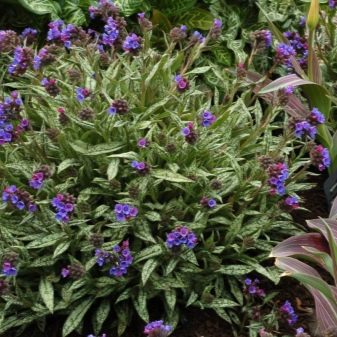

Landing
Before planting a plant, it is important to find the most suitable place for it. The flower is best planted in partial shade. It is in such conditions that it will look the most vivid and beautiful. It is also worth remembering that plants cannot stand moisture stagnation. Therefore, they must be planted on a hill. The soil in the selected area should be loose and fertile. If necessary, organic or mineral fertilizers are applied to the soil.
The lungwort is planted in the spring. As a rule, purchased seedlings in containers are used for this purpose. The process of transplanting them into open ground consists of the following steps.
- To begin with, the soil on the site must be dug up. Further, the earth must be thoroughly loosened.
- Several landing holes are made on the site. They should be spaced 20-30 centimeters apart.
- A thin layer of pebbles or broken brick is laid at the bottom of the hole.
- Further, the drainage layer is covered with fertile soil.
- After that, you need to get the plant out of the pot with the seedling. It must be removed along with the earth. In this case, the rhizome of the plant will not be damaged.
- Having placed the plant in the hole, it must be covered with earth. The soil must be compacted and watered with settled warm water.
At the end, the soil next to the stem should be mulched with dry grass, straw or sawdust. This will prevent moisture evaporation.

Care
Growing lungwort outdoors is a simple process. Agricultural technology of these flowers consists of the following activities.
- Watering... Only young plants need regular watering. Adult flowers should not be watered too often. It is recommended to use warm and settled water for irrigation. It is best to irrigate the site in the evening.
- Loosening... Since the lungwort prefers light soil, the land on the site must be loosened regularly. In this case, water and nutrients will flow faster to the roots.
- Top dressing... The lungwort responds well to feeding. Fertilizers are usually applied 1-2 times per season. For the first time, flowers are fed in early spring. This is necessary for the active building up of green mass.
Plants should be inspected from time to time. All damaged and flabby sheets must be removed. After the end of flowering, it is worth cutting off the wilted peduncles. This is to ensure that plants do not multiply by self-sowing. The site with lungwort does not need special preparation for winter.
Plants are usually mulched with dry foliage or peat. This helps protect them from the cold. Only the narrow-leaved lungwort needs more serious shelter. Such plants are covered not only with a layer of mulch, but also with spruce branches.

Reproduction
It is very simple to breed lungwort at home. There are several common ways this flower can be propagated.
Seeds
This is the rarest method of breeding lungwort. The process consists of the following steps.
- Fresh planting material must be cleaned of debris.
- Sow it in containers filled with a nutrient substrate. The soil in the container should be light and loose.
- As soon as the first shoots appear in the container, the seedlings will need to be thinned out.
- The grown plants must be properly looked after. They are regularly watered with warm, settled water. The soil in the container is gently loosened. This is to prevent a dense crust from forming in the container.
- After the appearance of full-fledged green leaves, the seedlings must be dived.
- It will be possible to plant plants in open ground only after the soil warms up well.
By propagating flowers in this way, it is impossible to preserve the varietal characteristics of the selected lungwort. But you can get unusual plants with a spectacular color of foliage and flowers.
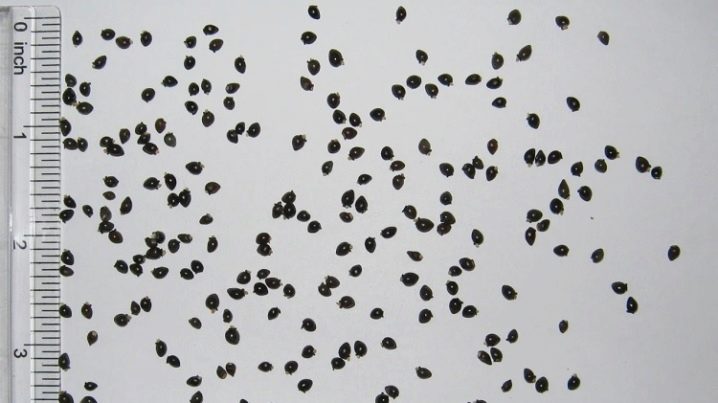
By dividing the bush
This method of breeding lungwort is the most popular.... It is recommended to divide the bushes at the age of 2-3 years. This is best done in early spring. The bush must be carefully dug out of the ground. The root must be cleaned of dirt. With a sharp knife or pruner, it must be divided into several parts. Immediately after dividing, new plants are planted in the selected location. After planting, the soil around the flowers must be mulched.
Rhizome
This is another common way of propagating adult plants. You need to do this at the end of the summer. The plant is also dug out of the ground. Several parts are separated from the rhizome. The prepared segment is immediately planted on the site. The distance between them should be within 20 centimeters.

Cuttings
It is also very convenient to propagate flowers by cuttings. The work uses short shoots with rosettes. They are carefully cut from the main plant. Then the slices are sprinkled with charcoal. After that, the cuttings are planted in the soil. The distance between individual seedlings should be within 20 centimeters. Young plants are looked after in the same way as for ordinary seedlings.
Diseases and pests
The lungwort has good resistance to most common diseases. But if the summer is rainy, the flower may be struck powdery mildew... When the first symptoms of this disease appear, the gardener needs to use antifungal drugs. This will allow you to quickly cope with the disease.
On the large foliage of lungwort, you can often see slugs... They are usually harvested by hand and destroyed. If there are a lot of pests on the site, you can sprinkle the soil next to the plants with crushed eggshells or wood ash. It will also keep pests away.

Application in landscape design
When planting a lungwort, it should be borne in mind that this is a primrose. The flower will look best next to other spring plants. The lungwort goes well with snowdrops, crocuses and tulips.


Since these flowers are shade-loving, they are often planted under trees. In the near-stem circle, they grow large and beautiful.
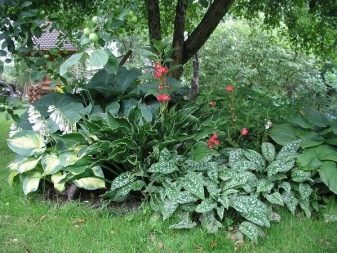

Plants can be placed next to an orchard or garden... After all, they attract pollinating insects to the site. For the same reason, they are planted next to the apiary.
In general, lungwort is an excellent plant for decorating your site. Unpretentious flowers do not need special care and delight people for a long time with their attractive appearance.















The comment was sent successfully.